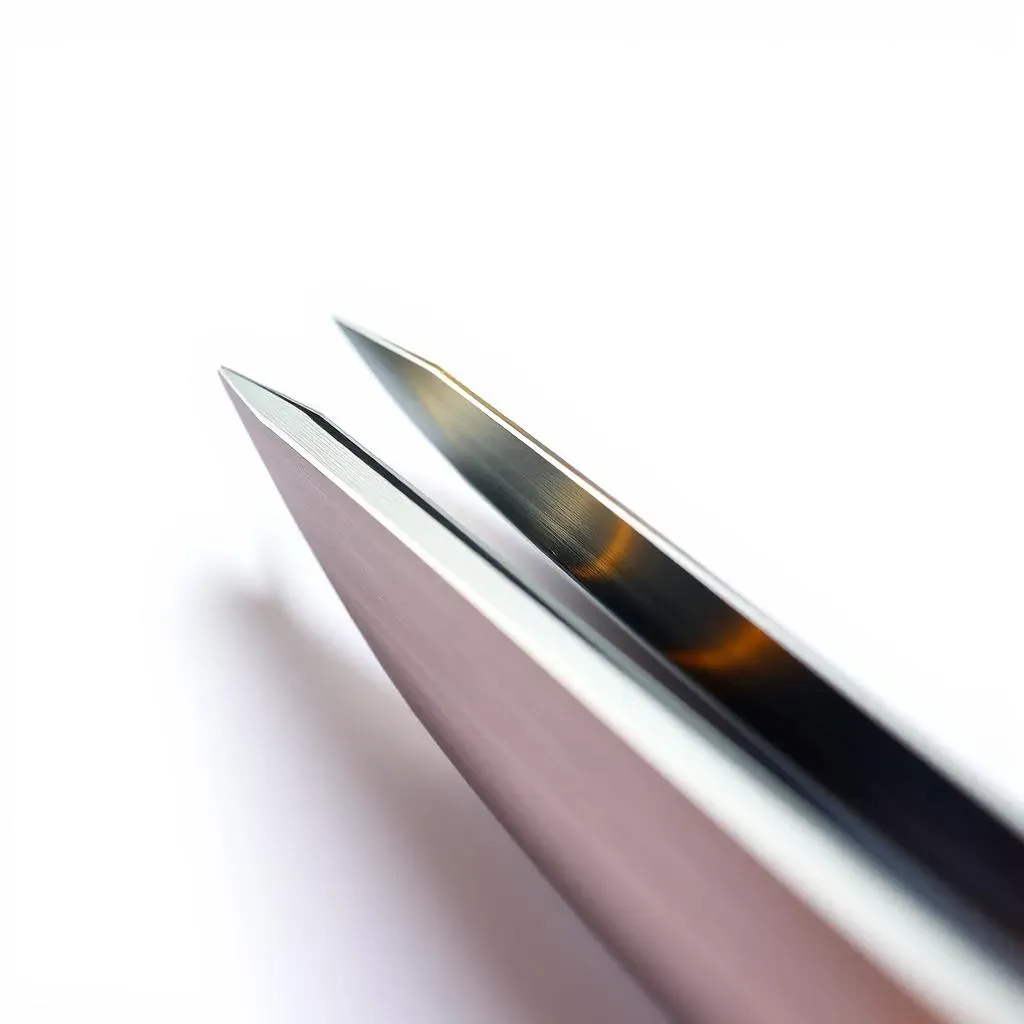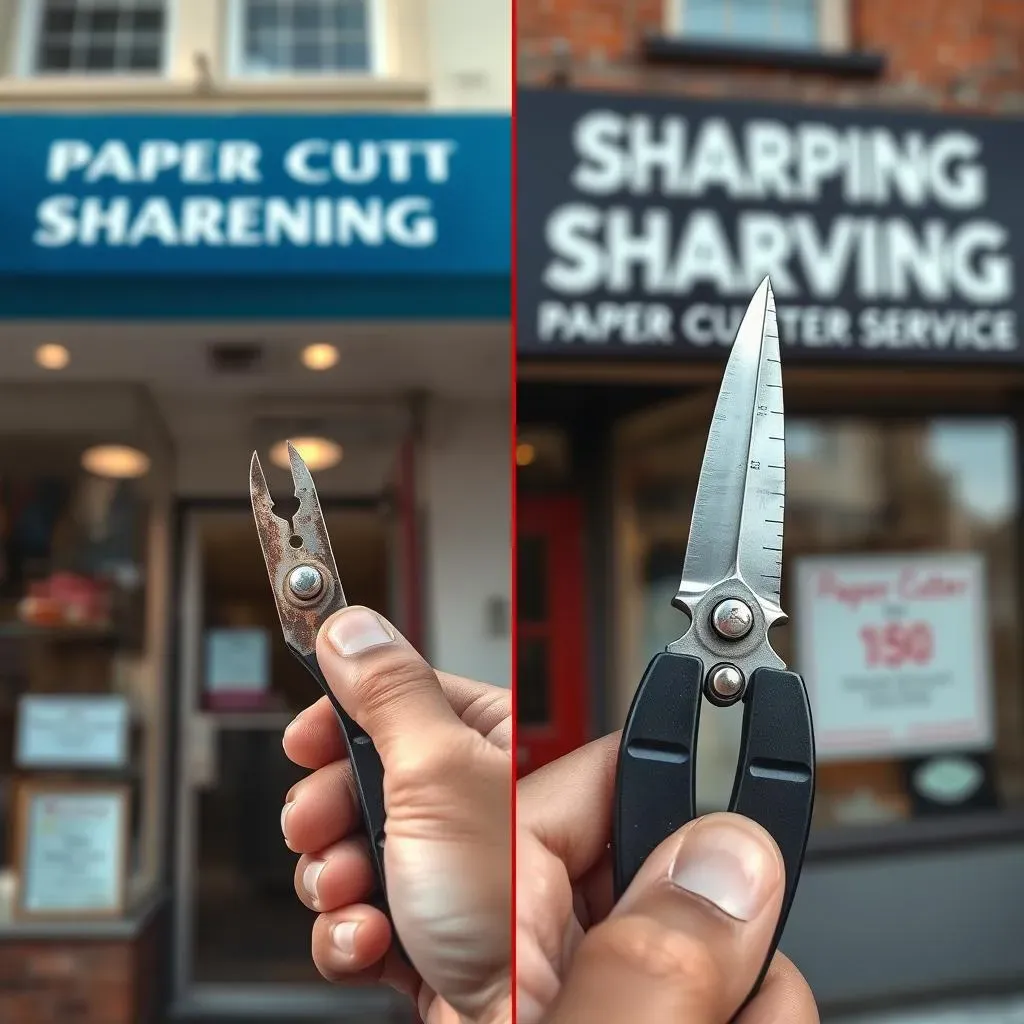Table of Contents
Have you ever stared at your paper cutter, its once-sharp blades now struggling to slice through a single sheet? Does the thought of replacing those blades fill you with a shudder of expense? Then you're in the right place! This article tackles the burning question: can paper cutter blades be sharpened? We'll explore the intricate world of paper cutter blades, examining their structure and how they work. This isn't just about knowing *if* you can sharpen them – it's about understanding *how* to do it effectively. We'll weigh the pros and cons of DIY sharpening versus professional services, providing you with practical advice and guidance. We'll also discuss when replacement blades are the smarter choice, and how proper maintenance can extend the life of your cutting tools. So, let's dive in and discover the best approach to keeping your paper cutter performing at its peak. From understanding the blade's design to exploring different sharpening techniques, we'll equip you with the knowledge to make an informed decision about your paper cutter's future. Whether you're a seasoned crafter, a meticulous office worker, or simply someone who values a clean cut, this guide will help you keep those blades performing like new. Remember, a sharp blade isn't just about aesthetics—it's about efficiency, precision, and preventing frustrating jams and uneven cuts. Get ready to explore the world of paper cutter blade maintenance and find the perfect solution for your needs.
Understanding Paper Cutter Blades: Structure and Function
Understanding Paper Cutter Blades: Structure and Function
The Anatomy of a Cut
Let's get down to the nitty-gritty. Most paper cutters use a guillotine-style mechanism. Think of two blades: a moving blade and a stationary one. The moving blade, the one that does the actual slicing, usually has a single, highly polished bevel. This bevel isn't just any angle; it's carefully crafted for optimal cutting performance. A dull blade? That's a bevel that's lost its sharpness. The stationary blade, on the other hand, often has two bevels, acting as a sort of anvil for the moving blade. Together, they create a shearing action, cleanly slicing through the paper like butter (well, almost!).
The design is crucial. Too shallow a bevel, and the blade won't cut cleanly; too steep, and it'll likely tear the paper. It's a delicate balance. The "V" shaped gap between the blades is equally important; it prevents friction and helps with clean cuts. Think of it like this: Imagine trying to cut a piece of paper with two perfectly flat surfaces. It wouldn't work! You need that slight gap for things to slide smoothly. And this is where things get interesting when we talk about sharpening. Modifying this delicate balance can be tricky, potentially ruining your blade if not done correctly.
Blade Type | Bevel(s) | Function |
|---|---|---|
Moving Blade | Single, highly polished | Primary cutting edge |
Stationary Blade | Double bevel | Anvil; enhances shearing action |
Understanding this fundamental structure is key to figuring out whether sharpening is even possible, and if so, how to do it safely and effectively. A little knowledge goes a long way in paper-cutting! For more intricate designs, check out our guide on paper cutting art.
Now, let's talk about the materials. Most modern paper cutters use high-quality steel blades. These are designed to be durable, but even the best blades will eventually dull with use. The type of steel also plays a role in how well they hold their edge. Some blades are self-sharpening, meaning they sharpen slightly with each cut. But, this process is gradual, and at some point, the blade will need more attention. This is where the 'can paper cutter blades be sharpened' question gets really interesting!
- High-carbon steel: Holds an edge well but can be more difficult to sharpen.
- Stainless steel: Easier to maintain but might not hold an edge as long.
- Other alloys: Different alloys offer different properties, affecting both cutting performance and sharpenability.
Knowing the material of your blades is important because it impacts the best way to sharpen or maintain them. For instance, does cutting paper blunt knives? The answer is yes, and that's relevant here too. We need to consider the wear and tear on the blades to understand how best to help them stay sharp.
Methods for Sharpening: DIY vs. Professional
Methods for Sharpening: DIY vs. Professional
DIY Sharpening: A Risky Adventure?
So, you're thinking of tackling this yourself? Brave, but maybe a little unwise. Remember that delicate balance we talked about? Messing with the bevels on your paper cutter blade is like performing brain surgery with a butter knife – risky! You could easily ruin the blade, leaving you with an even worse cutting experience than before. Plus, those blades are often made of hardened steel, requiring specialized tools and techniques to sharpen effectively. Unless you're a seasoned blade sharpener with experience working on precision instruments, I'd strongly advise against it. It's a bit like trying to do Chinese paper cutting without proper training – you might end up with a mess!
That said, if you're determined to try, proceed with extreme caution. Start with the absolute gentlest of sharpening methods, and only on a very dull blade. Even then, the risk of damage remains high. There are some YouTube videos that show people attempting this, but remember, their success doesn't guarantee yours. Always prioritize safety and be prepared for the possibility of a ruined blade.
- Use extremely fine grit sandpaper (at least 1000 grit).
- Apply very light pressure.
- Work slowly and carefully.
- Test frequently to avoid over-sharpening.
Professional Sharpening: The Safe Bet
This is my recommendation – hand your blade over to the professionals! There are specialized sharpening services that handle this kind of work all the time. They have the right tools, experience, and expertise to sharpen your blade without causing damage. They know the intricacies of various blade types and materials, ensuring a precise and effective sharpening job. Think of it like this: would you try to fix your car's engine yourself if you weren't a mechanic? Probably not! Similarly, entrusting your paper cutter blade to a professional is often the smarter move.
The cost of professional sharpening will vary depending on the size and type of your blade, as well as the location of the service. However, this cost is often far less than purchasing a new blade, and it guarantees a perfectly sharpened blade, ready to slice through paper with ease. Plus, you'll have peace of mind knowing it’s been done correctly. It's a small price to pay for a perfectly functional tool, especially if you're working on a large project, like creating amazing paper cutting decorations!
Method | Cost | Risk of Damage | Recommended for |
|---|---|---|---|
DIY | Low | High | Experienced sharpeners only |
Professional | Moderate | Low | Most users |
When to Replace Instead of Sharpen
Sometimes, sharpening isn't the answer. If your blade is severely damaged—chipped, bent, or excessively worn—replacing it is often the better option. Trying to sharpen a severely damaged blade is like trying to patch a hole in a tire with chewing gum. It might work temporarily, but it's not a long-term solution and could lead to bigger problems down the line. A badly damaged blade can lead to uneven cuts, paper jams, and even injury. It's crucial to assess the condition of the blade before deciding on a course of action. Check out our article on replacement blades for more information.
Replacing a blade is a relatively straightforward process, and many manufacturers provide instructions on how to do so. New blades will give you a crisp, clean cut every time, ensuring your paper-cutting projects come out perfectly. Plus, a new blade is often a more cost-effective solution in the long run than repeated attempts at DIY sharpening that might end in failure. If you're unsure, it's always best to err on the side of caution and replace the blade. Remember, a well-maintained paper cutter is a happy paper cutter, and a happy paper cutter makes for happy crafting!
Alternatives to Sharpening: Replacement Blades and Maintenance
Alternatives to Sharpening: Replacement Blades and Maintenance
Replacement Blades: A Fresh Start
Let's face it, sometimes a new blade is the best solution. Think of it as a spring cleaning for your paper cutter! Replacing your blades is cheaper than you might think, especially when you consider the time and potential frustration of attempting DIY sharpening. Plus, a brand-new blade guarantees a perfect cut every time. No more uneven slices or frustrating jams. Just clean, precise cuts that make your paper-cutting projects a joy. And finding replacement blades is easier than ever. Many online retailers and office supply stores stock blades for various paper cutter models. You can even find compatible blades from third-party manufacturers, often at a lower price point. For specific models, like the Swingline 9312, finding the right replacement is simple. Check out our article on replacement blades for Swingline 9312 for detailed information and purchasing tips.
Replacing the blade is usually a straightforward process. Most paper cutters have a simple mechanism for removing and installing blades. Consult your paper cutter's manual for specific instructions. This usually involves releasing a lever or a clasp, then gently sliding the old blade out and the new blade in. It's quick, easy, and will have you back to cutting in no time. Remember, safety first! Always unplug your paper cutter before handling the blades. For more tips on paper cutting tools, check out our guide on essential paper cutting supplies.
- Check your paper cutter's manual for specific instructions.
- Always unplug the machine before changing blades.
- Handle blades carefully to avoid cuts.
Regular Maintenance: The Unsung Hero
Even with the best blades, regular maintenance is key to keeping your paper cutter running smoothly. Think of it as preventative maintenance for your car—it helps prevent bigger problems down the road. Regular cleaning will remove paper dust and debris that can accumulate over time, potentially causing jams or dulling the blades. Use a soft brush or compressed air to clean the cutting area. For stubborn residue, a slightly damp cloth can help. Avoid harsh chemicals or abrasive cleaners, as these can damage the blade's finish.
Another crucial aspect of maintenance is proper storage. When not in use, cover your paper cutter to prevent dust accumulation. Store it in a clean, dry place, away from direct sunlight or extreme temperatures. These simple steps can significantly extend the life of your paper cutter and keep it running like new. For those intricate designs, remember to check out our guide on how to do paper cutting design. It's all about keeping things sharp and organized for top-notch results!
Maintenance Task | Frequency | Tools Needed |
|---|---|---|
Cleaning | After each use, or as needed | Soft brush, compressed air, damp cloth |
Storage | When not in use | Cover or protective case |